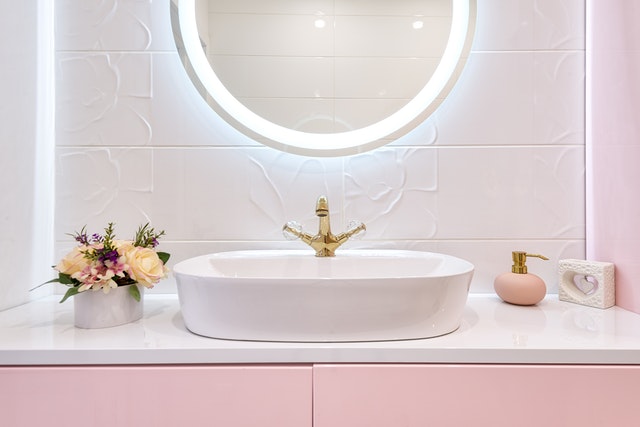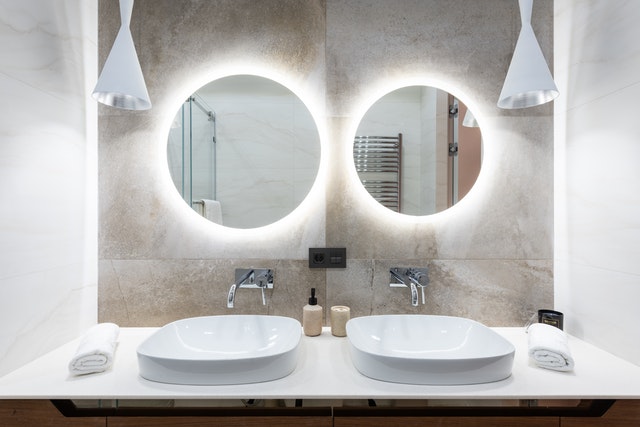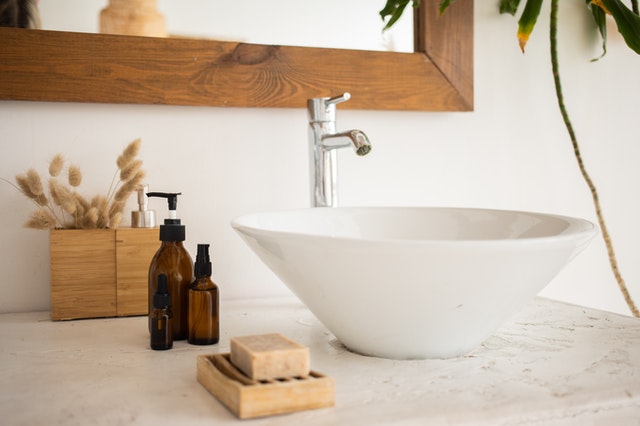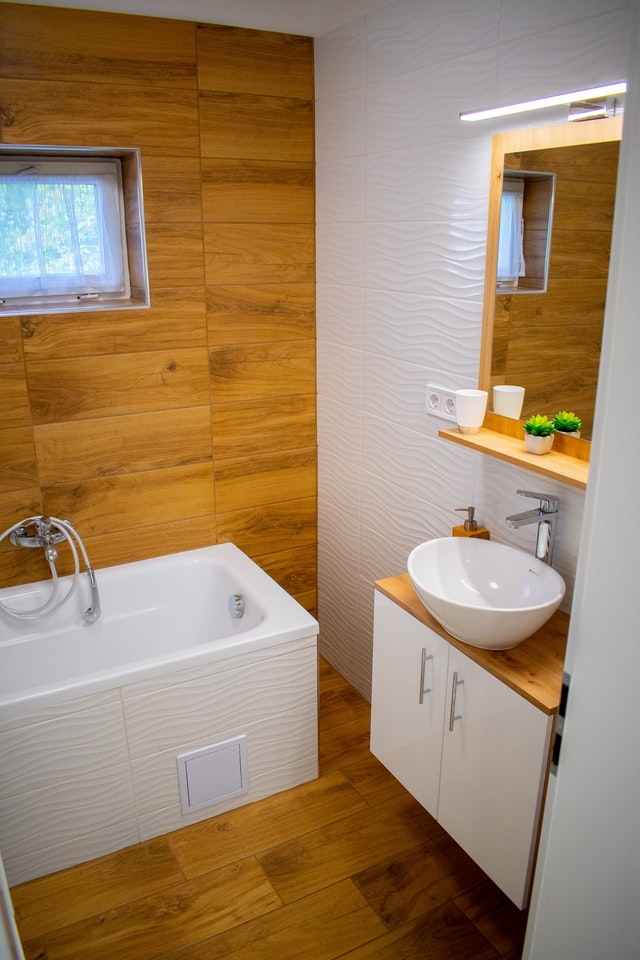Vitreous China
Made from a clay-and-mineral mixture that is glazed and then fired at high temperatures, vitreous china is the oldest, most common sink material. These high-gloss sinks are scratch-and stain-resistant, and require only minimal maintenance. It’s hard to beat the cleanability and decades of durability that come with vitreous china,’’ says architect Paul DeGroot. if that’s not enough, brands such as Porcher (from American standard) boast an antimicrobial surface glaze on some china sinks that makes it even harder for stains and other nasties to gain a foothold. Although featured more often on toilets and tubs, the glaze, called ever clean, is also available on some sinks.
Pros: When glazed and fired properly, vitreous china absorbs no water at all, making it long-lasting and sanitary. The material is also popular in basic, entry-level sinks, making it an economical choice.
Cons: Although less likely to chip or crack than other sinks, vitreous-china lavas are susceptible to damage from heavy impact.
Glass
Colored, textured, flecked, studded, or otherwise adorned, glass sinks are an artful addition to any bathroom tempered handmade glass is most often used to create vessel sinks, but some undercounter styles (with clear, colored, or frosted finishes,)are becoming popular options. Glass sinks are elegant, versatile, and surprisingly durable. “It’s much more forgiving; you don’t see the drips and every splash. You’re not wiping it down 24/7.’’
Pros: Most glass is stain-resistant and can be cleaned with any household cleanser.
Cons: Glass sinks can be pricey, and they show soap and water spots easily.
Fireclay
In use since the 19th century, fireclay, like vitreous china, is made from a clay-and mineral mixture, but is fired at a higher temperature, making it even more resistant to extreme heat. The difference between the two lies primarily in the manufacturing process rather than the material itself. Fireclay is smooth and nonporous, and it won’t fade or discolor. Its strength makes it the material of choice for many pedestals and console-style vantites. “Thicker and more dense than those made from vitreous china,’’ says Travis Rotelli of kohler, “fireclay sinks are found more often in the kitchen than in the bath.’’
Pros: Fireclay sinks are lead-free and highly resistant to chips, stains, and scratches.
Cons: Sometimes heavy, they often require additional structural support.
Stainless steel
Stainless-steel sinks come in several gauges, or thicknesses. Thicker metals are naturally more durable—and expensive. Stainless-steel lavs are available in high-end mirrorlike finishes, but it’s just extra buffing that gives them that brilliant shine. Brushed finishes don’t compromise durability. “Stainless-steel sinks are very trendy, but they can be noisy and appear commercial and cold-feeling,’’ says Gray Uhl of American standard.
Pros: Stainless-steel sinks are tough and can withstand extreme temperatures.
Cons: Stainless steel scratches and dulls over time, and it comes in only one color.
Stone
Bath sinks can be carved from an extraordinary array of natural stones—from granite and marble to onyx, limestone, and even petrified wood. Stone sinks are typically available in vessel (countertop) styles and in a variety of colors. Because stone is so porous, these sinks are often sealed before shipping. It’s recommended that they be resealed every year; nevertheless, some designers advise against heavy daily use. “I did a half-granite rock with the middle scooped out. It was sculptural, but it weighed 150 Ib.’’ says architect engineer and thousands of dollars.’’
Pros: Few fixtures steal the show like hand-carved stone sinks.
Cons: It’s not uncommon for stone sinks to chip, break, or stain.
Enameled cast iron
One of the oldest fixture materials, cast iron is also one of the most durable. When porcelain enamel (in a wide range of colors) is applied over cast iron, the result is a workhorse of a sink with incomparable-able gloss and shine. Because these sinks are made from such a trusted, long-lasting material, kohler’s come with a lifetime guarantee against cracks, chips, or burns. “Recycled iron (as much as 80%) is used in the manufacturing process, so these sinks are considered by many to be green products,’’ says Travis Rotelli of Kohler.
Pros: Enameled cast-iron sinks are solid, afford-able, and easy to clean.
Cons: Installation may require extra support—and helping hands.
Synthetic
Synthetic lavatories represent a broad range of price, quality, and appearance, from budget-friendly ‘’cultured stone’’ to proprietary (and pricey) solid-surface materials. At the lower end, ground stone is mixed with synthetic resins, molded, and finished with a gel coating. Pricier solid-surface sinks are made from a blend of natural minerals and high-performance acrylics. Consistent colors and patterns run all the way through, allowing solid-surface materials to be cut, carved, routed, and inlaid to create a variety of designs. Because of the wide disparity in the quality of synthetic materials, it’s important to do research.
Pros: Synthetic-sink options are endless and available at all price points. Expensive ones are durable and can be repaired and renewed by sanding.
Cons: Heat may discolor some of these sinks, and coatings may crack over time. Appearance varies greatly with price.
Other materials
A sink made of brass, bronze, copper, hammered copper, or nickel is a true statement piece. Most are found at the higher end of the price scale, with hand-crafted bronze among the most expensive. Brushed nickel has a warm, brown-tone appearance and a vintage feel. Copper has natural antibacterial properties.
Pros: Most metal sinks age gracefully, developing a soft patina.
Cons: Constant cleaning and care are required.
Sorting through shapes
Choosing the shape of your lavatory can feel like sitting down to a geometry lesson in which you measure every angel and carefully calculate the area inside and out of the sinks on your short list. It also can come down to an immediate response; the conviction that the flat, minimalist pool you saw online is a must-have for your new powder room. Designers see it both ways. While scale and proportion make certain shapes more suitable for a particular space, the choice often comes down to aesthetics. Although certain shapes inherently offer a more modern vibe (rectangles fall into this category) and; others read as more traditional (ovals), almost any shape can work in any bath, depending on its material and general style. Given the imagination of today’s sink designers, though, there’s no question that shape has become one more critical consideration in choosing the perfect lav, and not always an easy one. Let’s say you come upon a really cool octagonal shape, and everyone agrees it’s really cool,’’ says Kallista’s Mckeone. “If it conflicts with everything else that’s going on in the bath, is it really that cool?’’





